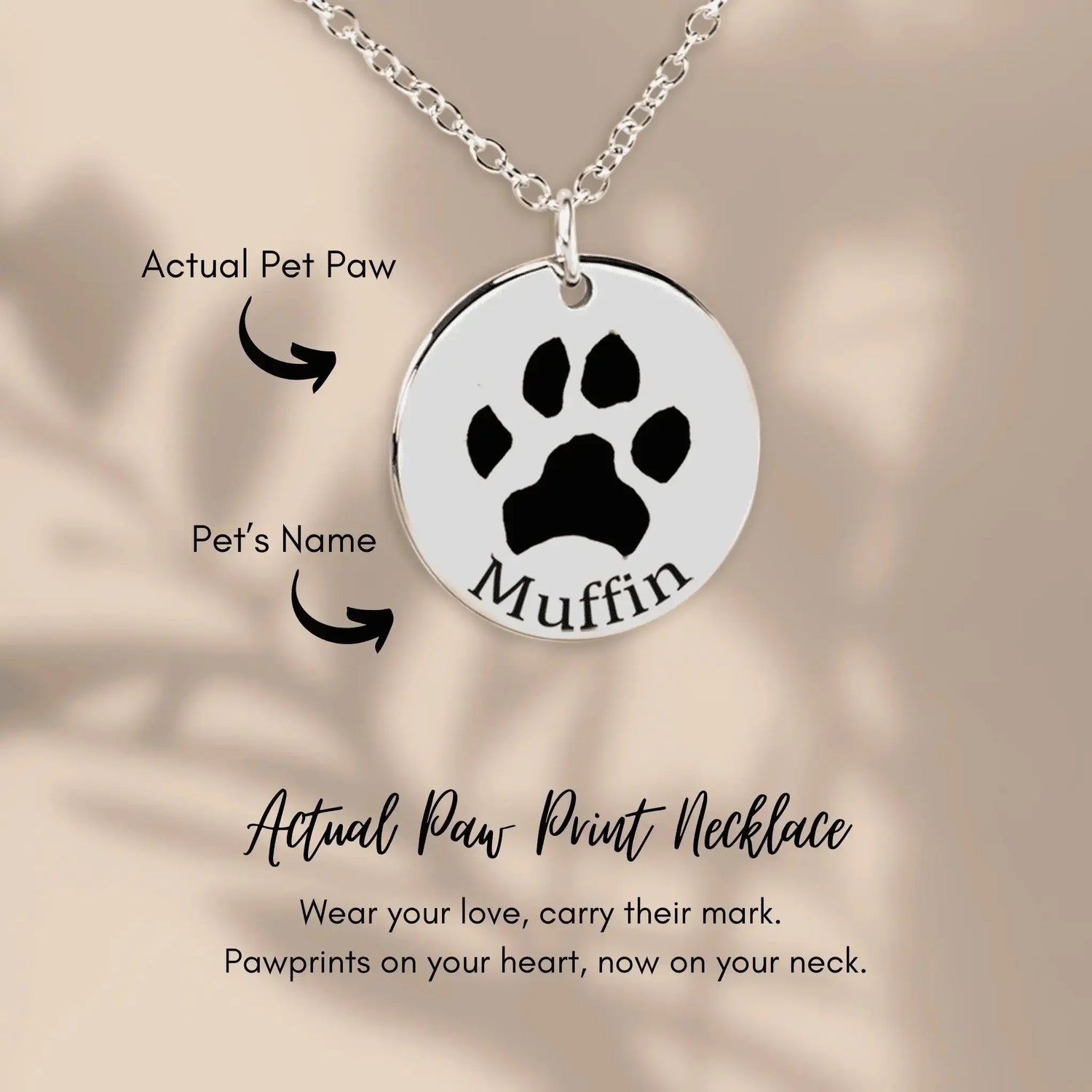How to Litter Train a Kitten: A Simple Guide from Floofie! 🐾

So you’ve brought home a new kitten! Welcome to the wonderful world of being a cat parent. Our own fluffy mascot, Floofie, knows that one of the first things on your mind is how to litter train a kitten. The good news? Kittens are naturally inclined to be clean, and our simple, positive approach is designed to work with their instincts, not against them. 😻
Your Kitten's First Potty Training Adventure
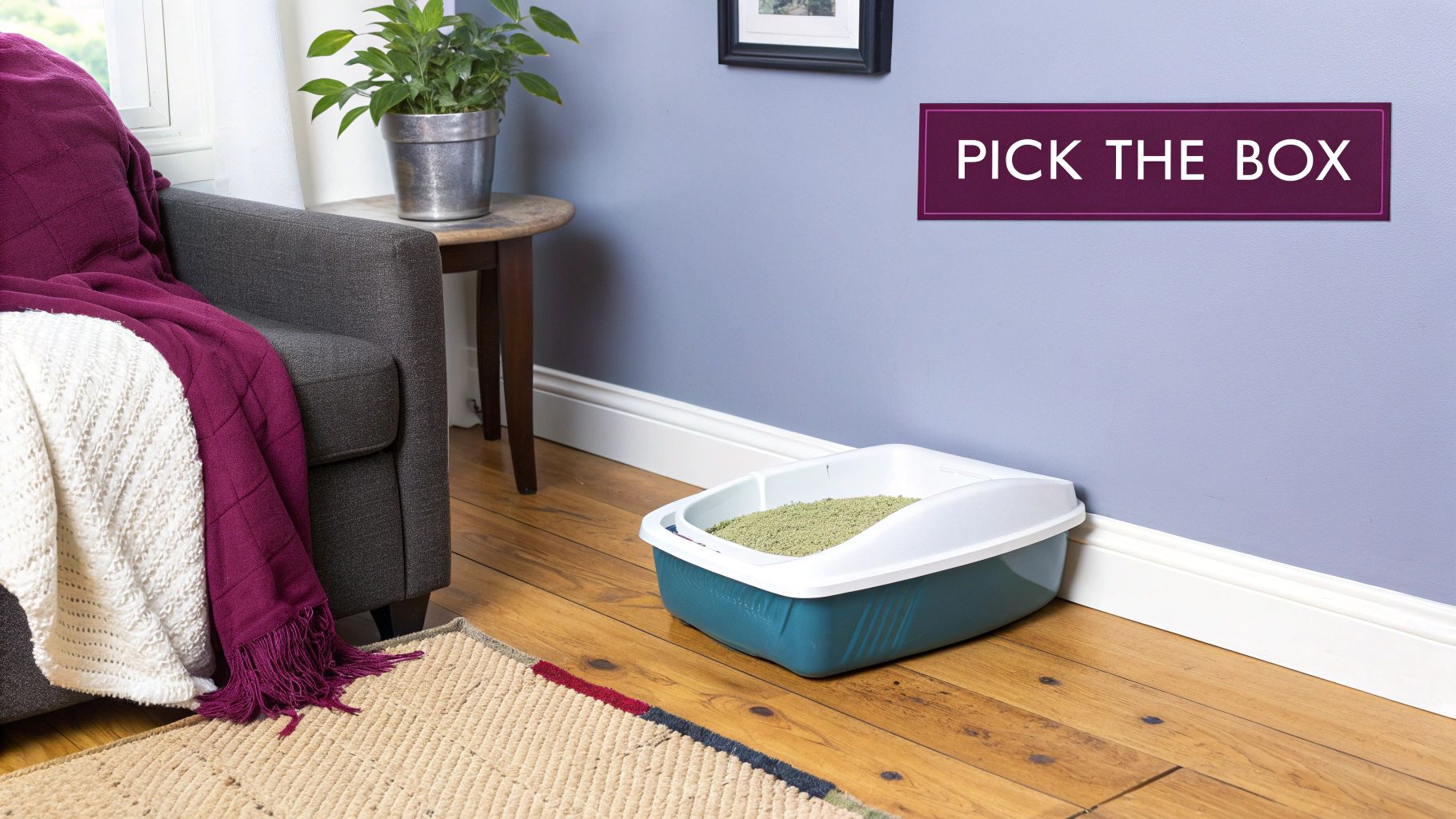
Get ready for one of the most rewarding (and surprisingly easy) parts of raising your tiny tiger. Litter training is about so much more than just preventing messes—it's about building trust and understanding your kitten's natural behaviors. Most felines are naturals at this, often picking it up within just a few days of being shown their new potty palace.
Think of this guide as your personal roadmap to a clean and happy home. Our pal Floofie has helped us pack it with playful, practical advice that actually works. We're skipping the stress and focusing on positive paws-itivity!
What to Expect on This Journey
This little adventure is all about setting your fur baby up for a lifetime of success, right from the very beginning. We're going to cover everything you need to know to make the process smooth for both of you.
Here's a little peek at our game plan:
- Choosing the Purr-fect Gear: We'll help you pick out the right-sized box, kitten-safe litter, and all the other essentials for the ultimate kitten starter kit.
- Gentle Introductions: You'll learn how to make the litter box a welcoming, positive space your kitten actually wants to use.
- Celebrating Success: We'll show you exactly how to reinforce good habits with plenty of praise and maybe a few well-deserved rewards.
- Troubleshooting Tips: Accidents happen! If there's a little "oopsie," don't worry. We have gentle solutions for all the common hiccups.
By following these simple steps, you and your new best friend will be on the right paw in no time. Let's get started! 🎉
Setting Up the Perfect Kitten Bathroom
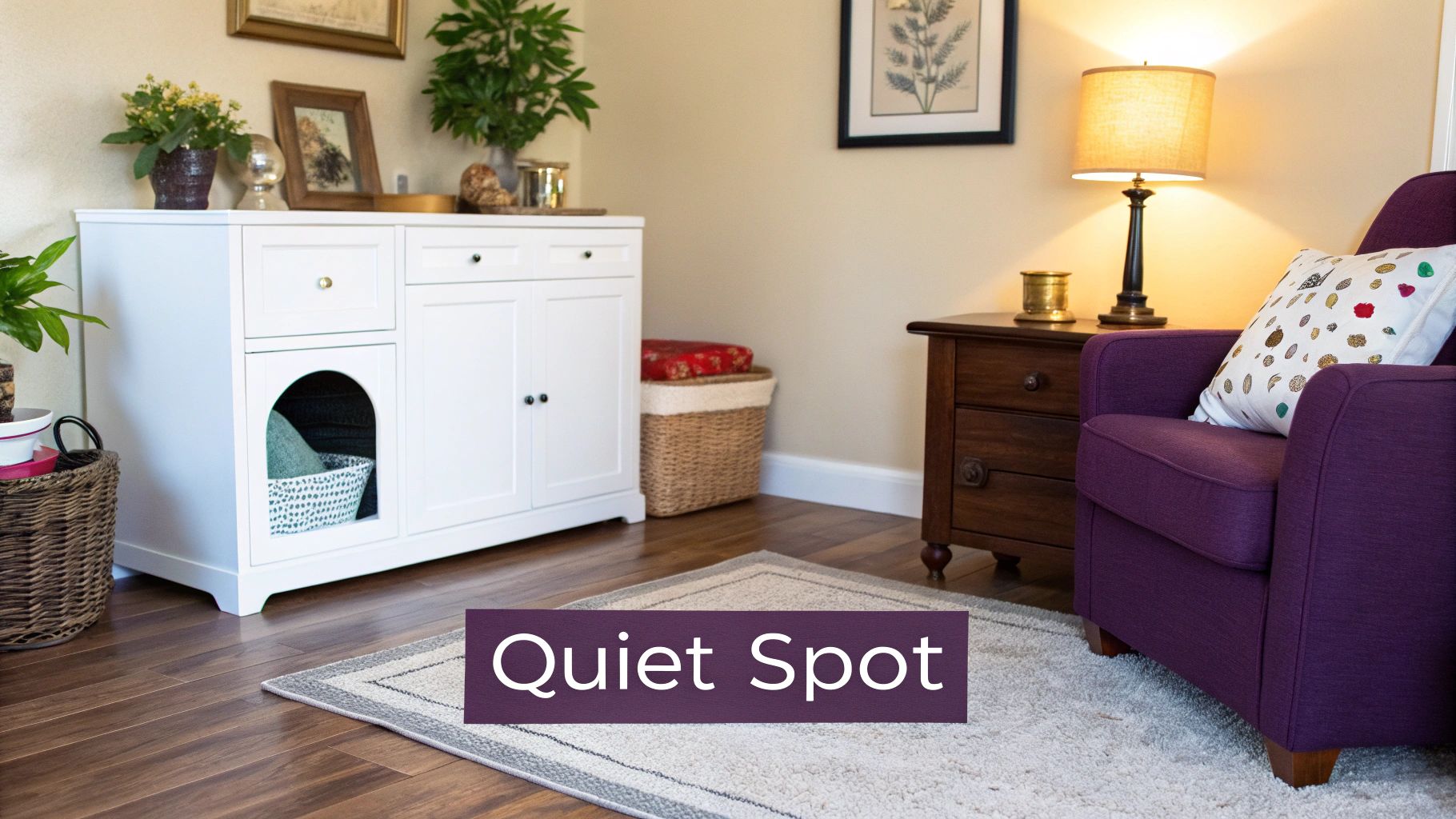
Alright, let's get down to business and create the five-star bathroom your new furball deserves. Our mascot, Floofie, will tell you that the secret to litter training a kitten starts with the right setup. Think of it as designing a tiny, irresistible potty palace. 👑
First things first: the throne. Your kitten has itty-bitty legs, and a standard high-sided box is like asking them to scale Mount Everest just to do their business. You'll want to start with a shallow, low-sided litter box that’s a breeze for them to hop in and out of. As they grow into a majestic floof, you can upgrade to a bigger model.
Next up is the litter itself. Kittens are curious and explore the world with their mouths, which means they’re probably going to taste-test whatever is in their box. It's crucial to choose an unscented, non-clumping litter. Clumping litter can cause serious internal blockages if a tiny tummy ingests it, so save that for when they're older and wiser.
Floofie's Kitten Litter Box Shopping List
To make things super simple, here's a quick-glance table to help you grab the perfect starter kit. This is everything you need for litter-training success!
| Item | Why Your Kitten Needs It (Floofie's Advice!) | Our Fave Product Type |
|---|---|---|
| The Box | Kitten legs are short! A low entry point prevents them from giving up and finding an easier spot to go (like your rug). | A shallow, open-top litter box with low sides. No lids or flaps for meow! |
| The Litter | Kittens are notorious taste-testers. Non-clumping is the only safe option to avoid dangerous internal blockages. | Unscented, non-clumping litter. Pellet styles (paper, corn) are great choices. |
| The Scoop | Daily scooping keeps the box clean and inviting. A happy box means a happy kitten who will actually use it. | A sturdy litter scoop with sifting slots appropriate for your litter type. |
| The Mat | This will be your best friend. It catches stray litter tracked out on their little paws, keeping your floors much cleaner. | A textured litter-trapping mat placed right outside the box. |
Getting these four items right from the start sets you and your kitten up for a smooth and accident-free training journey.
Finding the Purr-fect Location
Location, location, location! Where you put the box is just as critical as what’s in it. You wouldn't want your toilet in the middle of a busy hallway, right? Neither does your kitten.
Find a spot that is:
- Quiet and private. A low-traffic corner where they can feel safe and secure is ideal.
- Easily accessible. Make sure they can get there in a hurry when nature calls.
- Away from their food and water. Cats are instinctually clean and, well, nobody likes to eat in the bathroom!
Setting up a safe and welcoming space is a massive part of the process. For more tips on making your whole house a feline-friendly paradise, check out our guide on how to cat proof your home.
Floofie's Tip: Most kittens are ready to start using a litter box around 3 to 4 weeks of age, right when they begin weaning from their mom. Before this, their momma cat handles all the cleanup! This is the golden window to introduce them to their very own safe, low-sided box.
Making a Gentle Introduction to the Litter Box
Alright, the potty palace is officially open for business! Now it's time for the grand tour. This part is all about making the litter box a positive, interesting, and totally non-scary place for your new fluffball. The number one rule? Never force it. We're aiming for gentle persuasion and happy vibes only.
The best time to make the introduction is right after your kitten eats or wakes up from a catnap. These are peak potty moments when nature is most likely to call! Just pick up your tiny tiger and place them gently inside their new luxurious litter box.
Let them sniff around and get a feel for the new texture under their paws. Don't be surprised if they hop right out—that’s totally normal! The goal is simply to create a positive association, not to get them to use it on the first try.
The Magical Paw Dig Technique
To help trigger their natural instincts, you can try the "paw dig" technique. Gently take one of your kitten's front paws and make a soft scratching motion in the litter. This simple action often clicks something in their brain, reminding them of what their momma cat taught them about digging and burying.
This three-step process shows just how simple that first positive connection can be.
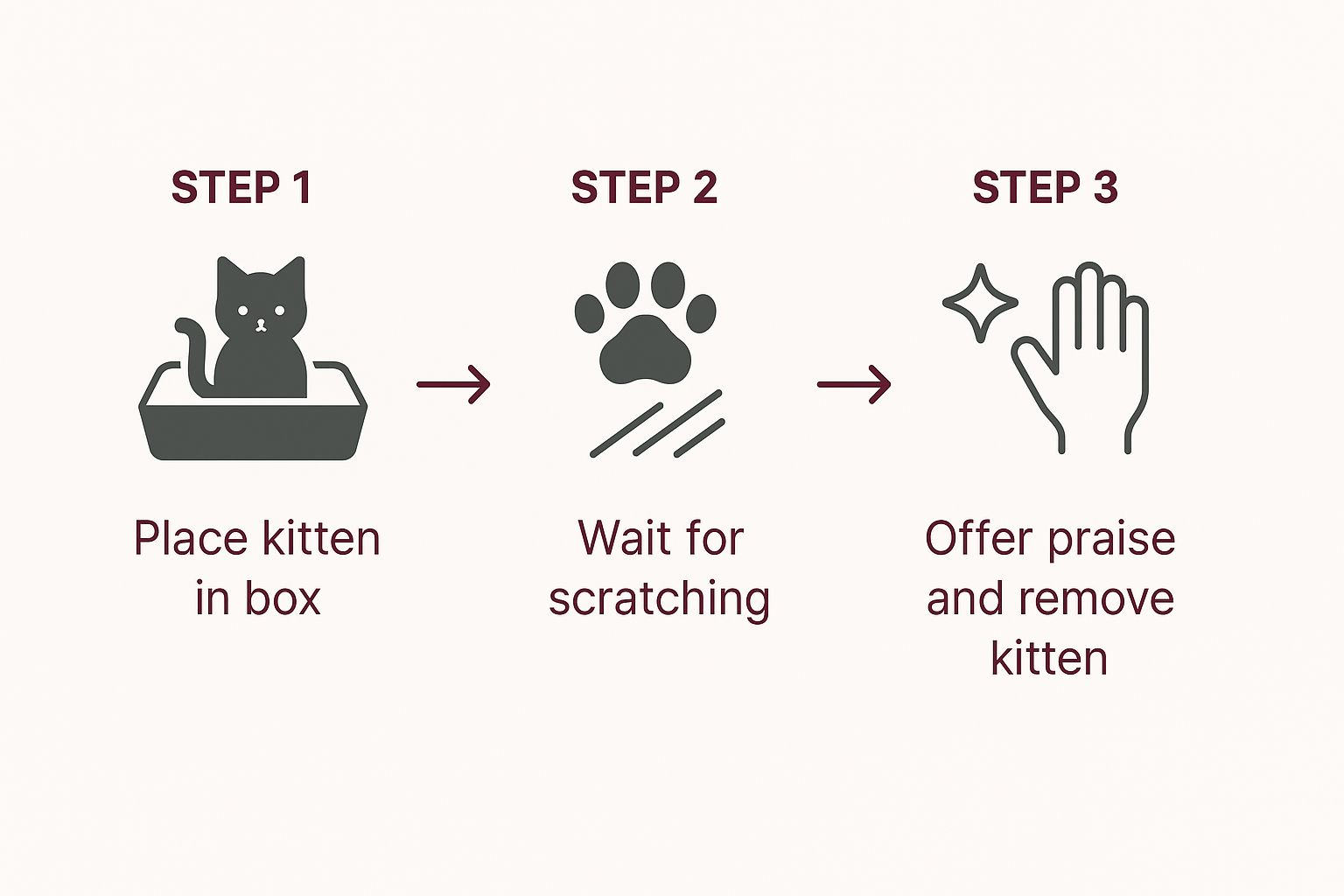
As you can see, the introduction is just a quick, positive interaction focused on praise, not pressure.
Floofie's Fun Fact: A scientific approach to training aligns perfectly with our gentle methods! Studies on kitten social behavior found that consistent, positive introductions lead to a 30% faster learning rate.
In fact, behavioral scientists have found that approximately 85% of kittens respond positively to these tactile and scent-based cues within the first week. By placing them in the box after meals and gently guiding their paws, you’re just reinforcing instincts they already have. For more awesome kitty science, you can learn more about kitten behavior fundamentals.
Whether they go potty on the first try or just explore a bit, shower them with praise, gentle pets, and maybe even a tasty treat. This positive reinforcement is what builds a happy, lifelong connection with their bathroom. 💖
Building Good Habits with Positive Reinforcement
You're doing great! Now that your kitten knows where the bathroom is, it's time to lock in that behavior and make it a lifelong habit. Consistency is your new best friend here.
A reliable routine is the secret sauce for making litter training stick. The goal is to make using the box a totally stress-free, automatic part of your kitten's day. And that all starts with keeping their personal potty palace pristine.
Keep It Squeaky Clean
Let's be real—would you want to use a dirty toilet? Your kitten feels the exact same way. A strict cleaning schedule isn't just a suggestion; it's a must.
- Scoop Daily: Get in the habit of scooping waste at least once a day with a good scoop. This simple step keeps odors at bay and makes the box a much more inviting place for your tiny floof.
- Full Refresh Weekly: Once a week, it's time for a deep clean. Dump all the old litter, give the box a good scrub with mild, unscented soap and warm water, and refill it with fresh litter.
This little bit of effort goes a long way in encouraging your kitten to keep coming back to their designated spot.
Floofie's Pro Tip: The good news is that about 90% of kittens catch on to using a litter box with just basic guidance, thanks to their natural instincts. Issues usually only pop up in about 10% of cases, and they're often tied to a dirty box or a hidden health problem. Set them up for success! Find out more about kitten potty habits on purina.com.
Master Feline Paws-ychology ✨
Every single time you see your kitten use their box successfully, it's party time! Positive reinforcement is an incredibly powerful tool in your training toolkit.
Shower them with gentle praise, some affectionate head scratches, or a special tasty treat the second they finish their business. This builds a super positive connection with the litter box in their little minds. They'll quickly learn, "Hey, when I go potty in this box, I get awesome things!"
Never, ever punish a kitten for having an accident. It only creates fear and anxiety, which can derail your training efforts and make things much harder. Keep every interaction happy and rewarding, and they'll get the hang of it in no time. For more ways to make your home a fun zone, check out our guide on how to entertain indoor cats.
Troubleshooting Common Litter Box Mistakes
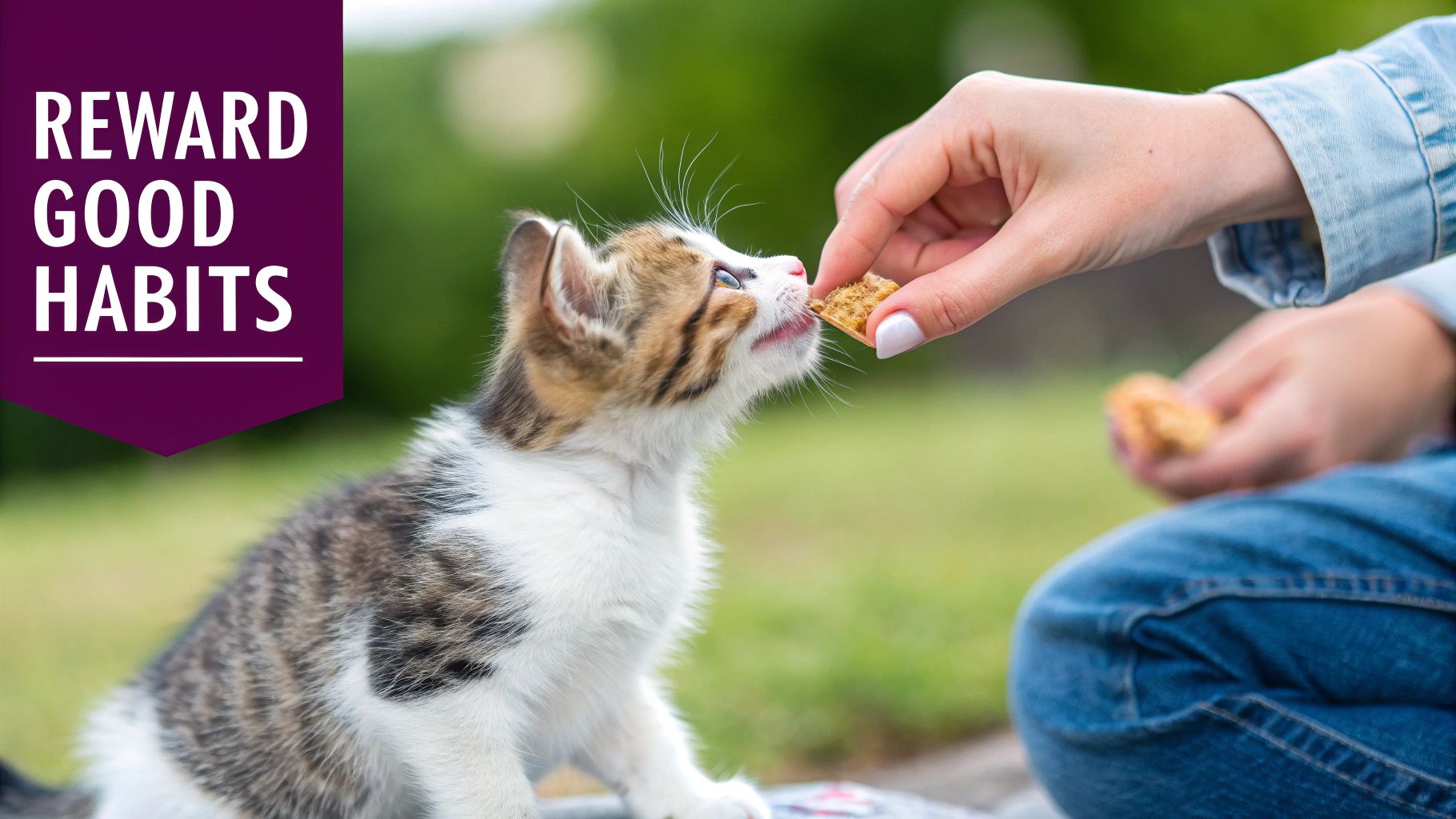
So you found an "oopsie" outside the litter box. Don't panic! Our mascot Floofie wants you to know that accidents are just your kitten's way of sending an S.O.S. signal. It’s time to put on your detective hat 🕵️♀️ and figure out what they’re trying to tell you.
First thing's first: punishment is never the answer. It only creates fear and confusion, which can make the problem even worse. Instead, let's approach this with kindness and curiosity. Most of the time, the reasons for litter box avoidance are surprisingly simple to fix once you know what to look for.
Becoming a Potty Problem Detective
Let's investigate the usual suspects behind those little mishaps. Your kitten is likely trying to communicate one of these key things.
- "My bathroom is dirty!" This is the #1 reason for accidents, hands down. Cats are impeccably clean creatures. Scoop the box daily and give it a full refresh with new litter weekly. A clean box is a happy box!
- "I don't like this location." Is the box next to a rumbling washing machine or in a high-traffic hallway? Your kitten needs a quiet, private spot to feel safe enough to do their business. Think low-traffic, but easily accessible.
- "I'm not feeling well." If accidents are sudden and frequent, it's crucial to rule out a medical issue. A UTI, for instance, can cause painful urination that your cat might associate with their litter box. If your kitten seems uncomfortable, a vet check-up is always the best first step. You can learn more by reading up on Understanding and Managing Feline Lower Urinary Tract Disease to be better informed.
An accident is a form of communication. Your kitten isn't being naughty; they're telling you something is wrong with their box, their environment, or their health. Listening is key!
Another quirky habit you might notice is your kitten not burying their waste. Sometimes this is a sign of them marking their territory, or simply a skill their mother didn't teach them. You can gently take their paw and show them the "dig and cover" motion to remind them.
And if you've ever seen them bolt out of the litter box like they've been shot out of a cannon, you might enjoy our post about why cats get zoomies after pooping.
Your Top Kitten Training Questions Answered
Still wrestling with a few questions about getting your kitten to master the litter box? Don't worry, it happens to the best of us. We’ve gathered the most common questions from new kitten parents to help you feel like a total pro. 🐾
Think of this as your go-to guide for those little "what-if" moments. Nailing these details can make the final stretch of training a breeze for both you and your tiny tiger.
How Many Litter Boxes Do I Really Need?
This is a fantastic question, and the answer often surprises people. The golden rule in the cat world is one litter box per cat, plus one extra. So yes, even for one little kitten, the ideal setup is two litter boxes.
So, why the extra box? Cats can be surprisingly particular about where they do their business. Having an option in two different, quiet locations gives them a choice and can prevent them from finding... less ideal spots (like behind the couch). It’s a simple strategy that can dramatically cut down on accidents.
Floofie's Final Word: "More choices make for a happy kitty! Two clean potty palaces are always better than one. It’s just good cat math!" 🤓
When Can I Switch to Clumping Litter?
Patience is a virtue with this one! You should wait until your kitten is at least 3 to 4 months old before you even think about introducing clumping litter. The reason is purely about safety.
Tiny kittens are endlessly curious and explore the world with their mouths. Unfortunately, this includes tasting their litter. If they swallow clumping litter, it can expand in their little digestive systems and cause a serious, life-threatening blockage. Stick with a safe, non-clumping litter to keep them out of harm's way until they're a bit older and wiser.
What if My Kitten Plays in the Litter Box?
First things first, don't panic! It’s completely normal for a kitten to see a big box of sandy stuff and immediately think, "PLAYGROUND!" 🥳 This is especially common when they're first getting used to the whole concept.
The key is gentle redirection. The second you see them digging for fun or pouncing around, grab a super-engaging toy like a feather wand or a crinkle ball. Lure them away from the box and kick off a fun play session somewhere else. Over time, they'll learn the box is strictly for business, and the living room floor is for fun.
At FloofChonk, we think every part of being a cat parent should be fun and rewarding. From mastering the litter box to finding the purr-fect cat-themed tee, we've got your back. Check out our collection of paw-some gear and accessories at https://www.floofchonk.com
